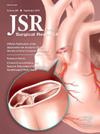Comparison of Risk Assessment Tools’ Prediction of Outcomes for Penetrating Trauma
IF 1.8
3区 医学
Q2 SURGERY
引用次数: 0
Abstract
Introduction
The Trauma and Injury Severity Score (TRISS) uses anatomic and/or physiologic variables to predict mortality; however, Injury Severity Score is less reliable for penetrating trauma. National Surgical Quality Improvement Program Surgical Risk Calculator (NSQIP-SRC) and American Society of Anesthesiologists Physical Status (ASA-PS) include functional status and comorbidities. This study evaluates the accuracy of these tools in predicting mortality, length of stay (LOS), and complications for operative penetrating trauma.
Methods
Adult penetrating trauma patients (≥18 y) who underwent surgery within 24 h of admission were included in this subgroup analysis of a prospective observational study at four trauma centers. The following three scoring models were compared: NSQIP-SRC, TRISS, and ASA-PS. Brier scores and area under the receiver-operating characteristic curve were used to compare mortality prediction. LOS prediction was assessed with linear regression and complications were evaluated with negative binomial regression. Likelihood ratio (LR) test was used to assess model fit.
Results
Of 329 penetrating trauma patients, 13 (3.9%) died. The median LOS was 4 d (interquartile range 2-9), and median number of complications was zero (interquartile range 0-1). TRISS better predicted mortality than NSQIP-SRC or ASA-PS on Brier score (0.02 versus 0.03 versus 0.03) but all had similar area under the receiver-operating characteristic curve (0.93 versus 0.93 versus 0.91, P = 0.26). NSQIP-SRC and ASA-PS better predicted LOS on adjusted R2 (14.4% versus 14.1% versus 1.6%) and LR showed no difference between these two tools (P = 0.16). NSQIP-SRC best predicted complications compared to TRISS and ASA-PS (Pseudo R2: 10.3% versus 3.8% versus 5.5%; LR: P = 0.003).
Conclusions
For penetrating trauma, all three models were similarly excellent at predicting mortality. NSQIP-SRC and ASA-PS better predicted LOS and NSQIP-SRC best predicted complications, suggesting these are better tools for prognostication of outcomes for penetrating trauma.
导言创伤和损伤严重程度评分(Trauma and Injury Severity Score,TRISS)使用解剖和/或生理变量来预测死亡率;但损伤严重程度评分对于穿透性创伤的可靠性较低。国家外科质量改进计划外科风险计算器(NSQIP-SRC)和美国麻醉医师协会体格状态(ASA-PS)包括功能状态和合并症。本研究评估了这些工具在预测穿透性创伤手术死亡率、住院时间(LOS)和并发症方面的准确性。方法将入院后 24 小时内接受手术的穿透性创伤成人患者(≥18 岁)纳入四家创伤中心前瞻性观察研究的亚组分析。对以下三种评分模型进行了比较:NSQIP-SRC、TRISS 和 ASA-PS。Brier 评分和受体运行特征曲线下面积用于比较死亡率预测。使用线性回归评估 LOS 预测,使用负二项回归评估并发症。结果 329 名穿透性创伤患者中有 13 人(3.9%)死亡。中位住院日为 4 天(四分位数间距为 2-9),并发症中位数为 0(四分位数间距为 0-1)。就 Brier 评分而言,TRISS 比 NSQIP-SRC 或 ASA-PS 更能预测死亡率(0.02 对 0.03 对 0.03),但两者的接收者操作特征曲线下面积相似(0.93 对 0.93 对 0.91,P = 0.26)。根据调整后的 R2,NSQIP-SRC 和 ASA-PS 更能预测 LOS(14.4% 对 14.1% 对 1.6%),而 LR 显示这两种工具之间没有差异(P = 0.16)。与 TRISS 和 ASA-PS 相比,NSQIP-SRC 预测并发症的能力最强(伪 R2:10.3% 对 3.8% 对 5.5%;LR:P = 0.003)。NSQIP-SRC和ASA-PS能更好地预测LOS,而NSQIP-SRC能更好地预测并发症,这表明它们是穿透性创伤预后的更好工具。
本文章由计算机程序翻译,如有差异,请以英文原文为准。
求助全文
约1分钟内获得全文
求助全文
来源期刊
CiteScore
3.90
自引率
4.50%
发文量
627
审稿时长
138 days
期刊介绍:
The Journal of Surgical Research: Clinical and Laboratory Investigation publishes original articles concerned with clinical and laboratory investigations relevant to surgical practice and teaching. The journal emphasizes reports of clinical investigations or fundamental research bearing directly on surgical management that will be of general interest to a broad range of surgeons and surgical researchers. The articles presented need not have been the products of surgeons or of surgical laboratories.
The Journal of Surgical Research also features review articles and special articles relating to educational, research, or social issues of interest to the academic surgical community.

 求助内容:
求助内容: 应助结果提醒方式:
应助结果提醒方式:


